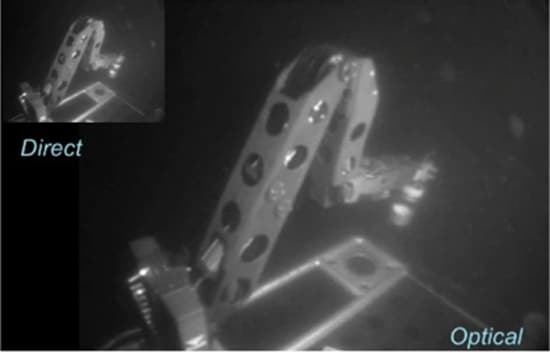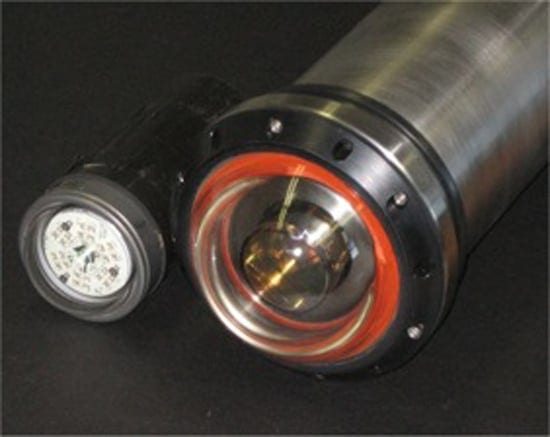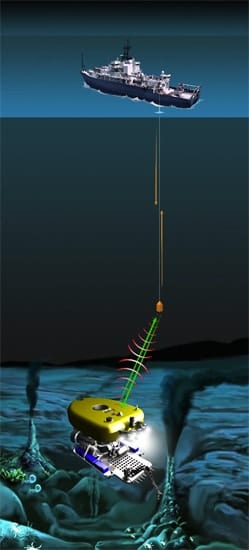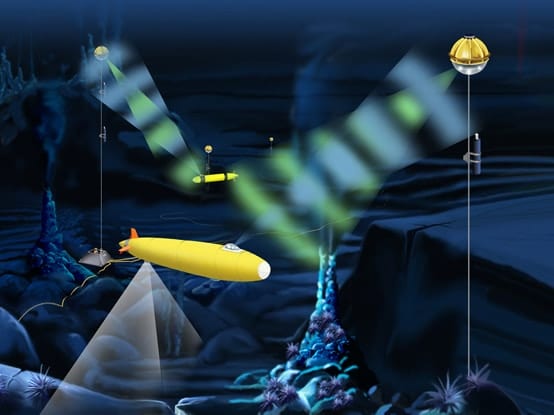Revolutionary Communications System Promises New Generation of Untethered, Undersea Vehicles
June 17, 2010
Woods Hole Oceanographic Institution (WHOI) engineers and scientists are employing a combination of new undersea technologies to re-define how we think of tethered, remotely operated vehicles.
Using the 11,000 meter-rated Nereus hybrid remotely operated vehicle (HROV) as a test platform, engineers at WHOI recently demonstrated a new communications and control system that integrates acoustics with optics. This achievement, they say, opens the way to new opportunities in communications between untethered remotely operated vehicles (UTROVs) and their human operators—literally “cutting the cord” for undersea exploration.
Traditional deep-water ROV operations with long, heavy tether cables result in high operating costs, driven by their need for ships with specialized positioning systems, large A-frames and winch systems. In addition, such vehicles often are limited by their tethering systems. In some cases, such as when working in Polar regions, these tethers may severely limit what can be achieved with present ROV technology.
Redefining what it means to be tethered promises to lower the cost of underwater robotic vehicles and significantly change how they are used. Because it enables communications without the heavy tether-handling equipment, the optical/acoustic system would require smaller, less-expensive ships and fewer personnel to perform undersea missions, said WHOI Senior Engineer Norman E. Farr, the team leader in developing the novel communications system.
Ongoing advances in control systems and energy storage will only serve to add momentum to a new class of underwater vehicle actively being developed at WHOI, says Andy Bowen, a research specialist and lead investigator of the WHOI UTROV team.
Bowen, Farr and their colleagues successfully tested an underwater optical modem, which allows instant data transfer and real-time video from battery powered un-tethered ROVs outfitted with sensors, cameras and manipulators to surface ships.
The first deep-water test of the optical communications system was performed on the human occupied vehicle (HOV) Alvin submersible in August 2008. Data were transmitted from a seafloor package to a receiver mounted on submersible. Alvin was moved to a series of stations and error rate data were collected. The system demonstrated error-free transmissions at 1 megabit per second (MBPS) at a range of more than 100 meters, the researchers reported.
A follow-up test was performed at the WHOI dock using Nereus. The demonstration successfully showed that the optical link enabled real-time control of the vehicle by transferring high-rate video, including direct human control while performing complex, unstructured manipulations under water.
“The recent development and successful testing of the HROV Nereus paves the way for a derivative vehicle-type, able to perform a variety of useful tasks such as rapid event response, deployment from ships of opportunity, time-series ocean observatory maintenance, and exploration at increasingly high latitudes, including beneath Polar ice,” says Bowen.
The test results clearly demonstrate that next-generation, battery-powered vehicles like Nereus, are capable of replacing conventional, tethered vehicles in performing an increasing range of tasks, the researchers say. “The unique, integrated combination of advancements in both acoustic and optical communications, coupled with the successful realization of a battery powered ROV, positions Woods Hole Oceanographic scientists and engineers to make broad and important contributions to the evolution of undersea robotic vehicles in the years to come,” says Bowen.
Farr likens optical/acoustic system possibilities to the world opened up by “your household wi-fi.” His co-investigator on optical communications, Dr. Maurice Tivey of WHOI, adds that “underwater optical communications are akin to the cell phone revolution…The ability to transfer information and data underwater without wires or plugging cables in is a tremendous capability allowing vehicles or ships to communicate with sensors on the seafloor.”
This July, WHOI plans the first large-scale deployment of the system at the Juan de Fuca Ridge off shore of the Northwestern United States. The WHOI team will employ Alvin to deploy the optical system on a sub sea data concentrator to collect and transmit geophysical data from wellheads situated at the undersea ridge.
Ultimately, Farr says, the system will “allow us to have vehicles [at specific undersea locations] waiting to respond to an event. It’s a game-changer.”
The Woods Hole Oceanographic Institution is a private, independent organization in Falmouth, Mass., dedicated to marine research, engineering, and higher education. Established in 1930 on a recommendation from the National Academy of Sciences, its primary mission is to understand the oceans and their interaction with the Earth as a whole, and to communicate a basic understanding of the oceans’ role in the changing global environment.




